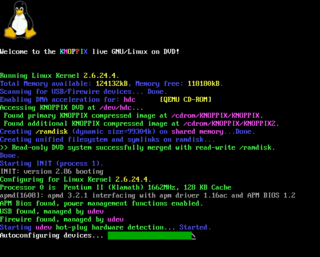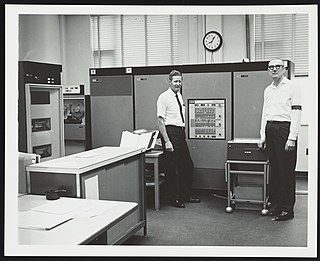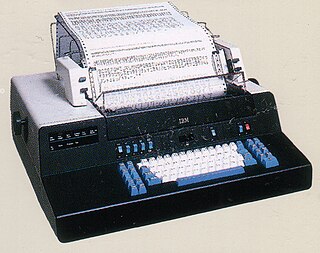
The IBM 3270 is a family of block oriented display and printer computer terminals introduced by IBM in 1971 and normally used to communicate with IBM mainframes. The 3270 was the successor to the IBM 2260 display terminal. Due to the text color on the original models, these terminals are informally known as green screen terminals. Unlike a character-oriented terminal, the 3270 minimizes the number of I/O interrupts required by transferring large blocks of data known as data streams, and uses a high speed proprietary communications interface, using coaxial cable.

The IBM System/360 (S/360) is a family of mainframe computer systems that was announced by IBM on April 7, 1964, and delivered between 1965 and 1978. It was the first family of computers designed to cover both commercial and scientific applications and a complete range of applications from small to large. The design distinguished between architecture and implementation, allowing IBM to release a suite of compatible designs at different prices. All but the only partially compatible Model 44 and the most expensive systems use microcode to implement the instruction set, featuring 8-bit byte addressing and binary, decimal and hexadecimal floating-point calculations.
The Honeywell 6000 series computers were rebadged versions of General Electric's 600-series mainframes manufactured by Honeywell International, Inc. from 1970 to 1989. Honeywell acquired the line when it purchased GE's computer division in 1970 and continued to develop them under a variety of names for many years. In 1989, Honeywell sold its computer division to the French company Groupe Bull who continued to market compatible machines.

A computer terminal is an electronic or electromechanical hardware device that can be used for entering data into, and transcribing data from, a computer or a computing system. The teletype was an example of an early-day hard-copy terminal and predated the use of a computer screen by decades. Starting in the mid-1970s with machines such as the Sphere 1, Sol-20, and Apple I, terminal circuitry began to be integrated into personal and workstation computer systems, with the computer handling character generation and outputting to a CRT display such as a computer monitor or, sometimes, a consumer TV.

One meaning of system console, computer console, root console, operator's console, or simply console is the text entry and display device for system administration messages, particularly those from the BIOS or boot loader, the kernel, from the init system and from the system logger. It is a physical device consisting of a keyboard and a printer or screen, and traditionally is a text terminal, but may also be a graphical terminal. System consoles are generalized to computer terminals, which are abstracted respectively by virtual consoles and terminal emulators. Today communication with system consoles is generally done abstractly, via the standard streams, but there may be system-specific interfaces, for example those used by the system kernel.

The IBM 1800 Data Acquisition and Control System (DACS) was a process control variant of the IBM 1130 with two extra instructions, extra I/O capabilities, 'selector channel like' cycle-stealing capability and three hardware index registers.

The IBM 5100 Portable Computer is one of the first portable computers, introduced in September 1975, six years before the IBM Personal Computer, and eight before the first successful IBM compatible portable computer, the Compaq Portable. It was the evolution of a prototype called the SCAMP that was developed at the IBM Palo Alto Scientific Center in 1973. Whether considered evolutionary from SCAMP or revolutionary, it still needed to be plugged into an electric socket.

IBM 5250 is a family of block-oriented terminals originally introduced with the IBM System/34 midrange computer systems in 1977. It also connects to the later System/36, System/38, and IBM AS/400 systems, and to IBM Power Systems systems running IBM i, as well as the Series/1 minicomputer.

The IBM 2250 Graphics Display Unit was a vector graphics display system by IBM for the System/360; the Model IV attached to the IBM 1130.

Uniscope was a class of computer terminals made by Sperry Rand Corporation, Univac Division, and successors since 1964 that were normally used to communicate with Univac mainframes. As such, it was the successor to various models of Teletype. Due to the text color on the original models, these terminals are informally known as green screen terminals.

The IBM 6580 Displaywriter System is a 16-bit microcomputer that was marketed and sold by IBM's Office Products Division primarily as a word processor. Announced on June 17, 1980 and effectively withdrawn from marketing on July 2, 1986, the system was sold with a 5 MHz Intel 8086, 128 KB to 448 KB of RAM, a swivel-mounted monochrome CRT monitor, a detached keyboard, a detached 8" floppy disk drive enclosure with one or two drives, and a detached daisy wheel printer, or Selectric typewriter printer. The primary operating system for the Displaywriter is IBM's internally developed word processing software titled "Textpack", but UCSD p-System, CP/M-86, and MS-DOS were also offered by IBM, Digital Research, and CompuSystems, respectively.

IMLAC Corporation was an American electronics company in Needham, Massachusetts, that manufactured graphical display systems, mainly the PDS-1 and PDS-4, in the 1970s.

A video display controller or VDC is an integrated circuit which is the main component in a video-signal generator, a device responsible for the production of a TV video signal in a computing or game system. Some VDCs also generate an audio signal, but that is not their main function.
Basic Telecommunications Access Method (BTAM) is a low-level programming interface specified by IBM for use on the IBM System/360 for start-stop and binary synchronous telecommunications terminals. Later, IBM specified higher-level interfaces QTAM and TCAM.
The IBM 2780 and the IBM 3780 are devices developed by IBM to perform remote job entry (RJE) and other batch functions over telephone lines; they communicate with the mainframe via Binary Synchronous Communications and replaced older terminals using synchronous transmit-receive (STR). In addition, IBM has developed workstation programs for the 1130, 360/20, 2922, System/360 other than 360/20, System/370 and System/3.

IBM 3767 Communication Terminal is a serial printer terminal that employed dot matrix print-head technology and, for the first time, the Synchronous Data Link Control (SDLC) communications protocol set under IBM's Systems Network Architecture (SNA). It was introduced in 1974 and was used widely during the late 1970s to 1990s, for attachment to IBM System/360 and System/370 mainframe computers and IBM System/7 as an alternative to a 2741 typewriter terminal.
The IBM 2790 Data Communications System is a family of devices intended for "in-plant data communications and production monitoring." It is described as a two-way data communications system designed to accommodate large volumes of short messages from many in-plant locations or from smaller groups of terminals at remote locations.

270x is a generic name for a family of IBM non-programmable communications controllers used with System/360 and System/370 computers.
The IBM 1015 is a display terminal for the IBM System/360. IBM suggested that it be used for phone-based customer support.















